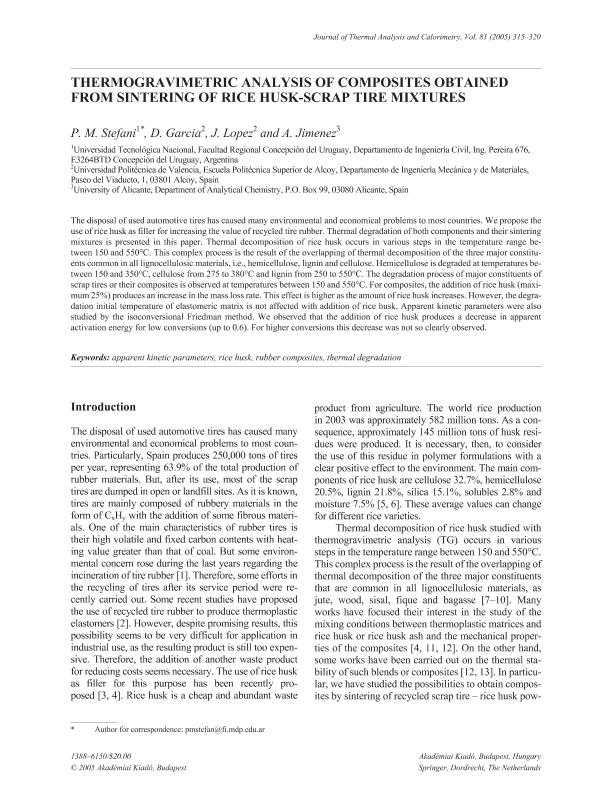Artículo
Thermogravimetric analysis of composites obtained from sintering of rice husk-scrap tire mixtures
Fecha de publicación:
01/2005
Editorial:
Kluwer Academic Publishers
Revista:
Journal of Thermal Analysis and Calorimetry
ISSN:
1388-6150
e-ISSN:
1572-8943
Idioma:
Inglés
Tipo de recurso:
Artículo publicado
Clasificación temática:
Resumen
The disposal of used automotive tires has caused many environmental and economical problems to most countries. We propose the use of rice husk as filler for increasing the value of recycled tire rubber. Thermal degradation of both components and their sintering mixtures is presented in this paper. Thermal decomposition of rice husk occurs in various steps in the temperature range between 150 and 550°C. This complex process is the result of the overlapping of thermal decomposition of the three major constituents common in all lignocellulosic materials, i.e., Hemicellulose, lignin and cellulose. Hemicellulose is degraded at temperatures between 150 and 350°C, cellulose from 275 to 380°C and lignin from 250 to 550°C. The degradation process of major constituents of scrap tires or their composites is observed at temperatures between 150 and 550°C. For composites, the addition of rice husk (maximum 25%) produces an increase in the mass loss rate. This effect is higher as the amount of rice husk increases. However, the degradation initial temperature of elastomeric matrix is not affected with addition of rice husk. Apparent kinetic parameters were also studied by the isoconversional Friedman method. We observed that the addition of rice husk produces a decrease in apparent activation energy for low Conversions (up to 0.6). For higher conversions this decrease was not so clearly observed.
Keywords: apparent kinetic parameters, rice husk, rubber composites, thermal degradation
Archivos asociados
Licencia
Identificadores
Colecciones
Articulos(INTEMA)
Articulos de INST.DE INV.EN CIENCIA Y TECNOL.MATERIALES (I)
Articulos de INST.DE INV.EN CIENCIA Y TECNOL.MATERIALES (I)
Citación
Stefani, Pablo Marcelo; García, D.; López, J.; Jimenez, A.; Thermogravimetric analysis of composites obtained from sintering of rice husk-scrap tire mixtures; Kluwer Academic Publishers; Journal of Thermal Analysis and Calorimetry; 81; 2; 1-2005; 315-320
Compartir
Altmétricas




